Attached files
| file | filename |
|---|---|
| EX-99.1 - PRESS RELEASE - Walmart Inc. | earningsrelease-10312016.htm |
| 8-K - FORM 8-K - Walmart Inc. | form8-kx10312016.htm |
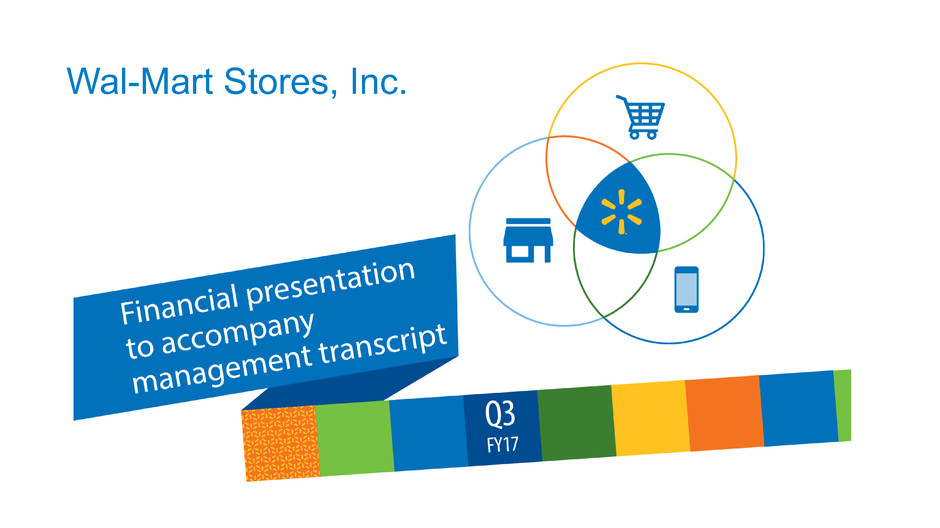
Wal-Mart Stores, Inc.
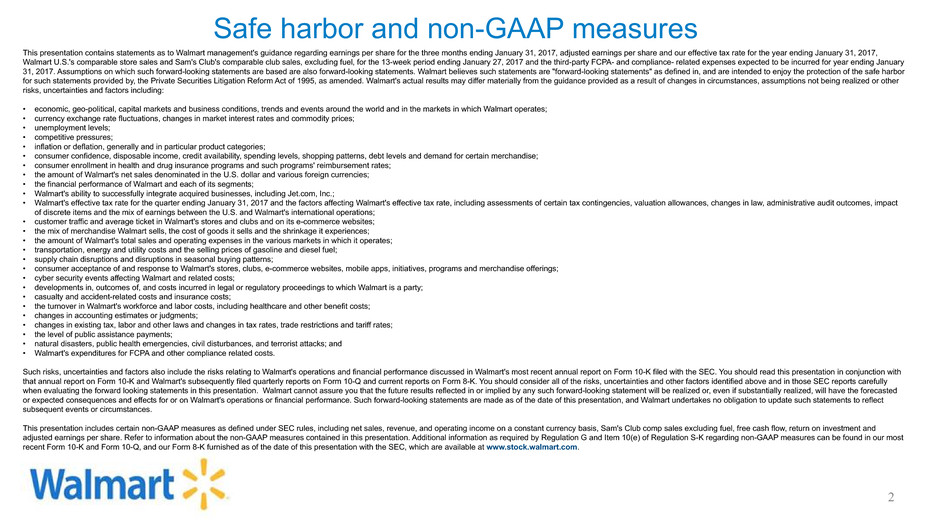
Safe harbor and non-GAAP measures
This presentation contains statements as to Walmart management's guidance regarding earnings per share for the three months ending January 31, 2017, adjusted earnings per share and our effective tax rate for the year ending January 31, 2017,
Walmart U.S.'s comparable store sales and Sam's Club's comparable club sales, excluding fuel, for the 13-week period ending January 27, 2017 and the third-party FCPA- and compliance- related expenses expected to be incurred for year ending January
31, 2017. Assumptions on which such forward-looking statements are based are also forward-looking statements. Walmart believes such statements are "forward-looking statements" as defined in, and are intended to enjoy the protection of the safe harbor
for such statements provided by, the Private Securities Litigation Reform Act of 1995, as amended. Walmart's actual results may differ materially from the guidance provided as a result of changes in circumstances, assumptions not being realized or other
risks, uncertainties and factors including:
• economic, geo-political, capital markets and business conditions, trends and events around the world and in the markets in which Walmart operates;
• currency exchange rate fluctuations, changes in market interest rates and commodity prices;
• unemployment levels;
• competitive pressures;
• inflation or deflation, generally and in particular product categories;
• consumer confidence, disposable income, credit availability, spending levels, shopping patterns, debt levels and demand for certain merchandise;
• consumer enrollment in health and drug insurance programs and such programs' reimbursement rates;
• the amount of Walmart's net sales denominated in the U.S. dollar and various foreign currencies;
• the financial performance of Walmart and each of its segments;
• Walmart's ability to successfully integrate acquired businesses, including Jet.com, Inc.;
• Walmart's effective tax rate for the quarter ending January 31, 2017 and the factors affecting Walmart's effective tax rate, including assessments of certain tax contingencies, valuation allowances, changes in law, administrative audit outcomes, impact
of discrete items and the mix of earnings between the U.S. and Walmart's international operations;
• customer traffic and average ticket in Walmart's stores and clubs and on its e-commerce websites;
• the mix of merchandise Walmart sells, the cost of goods it sells and the shrinkage it experiences;
• the amount of Walmart's total sales and operating expenses in the various markets in which it operates;
• transportation, energy and utility costs and the selling prices of gasoline and diesel fuel;
• supply chain disruptions and disruptions in seasonal buying patterns;
• consumer acceptance of and response to Walmart's stores, clubs, e-commerce websites, mobile apps, initiatives, programs and merchandise offerings;
• cyber security events affecting Walmart and related costs;
• developments in, outcomes of, and costs incurred in legal or regulatory proceedings to which Walmart is a party;
• casualty and accident-related costs and insurance costs;
• the turnover in Walmart's workforce and labor costs, including healthcare and other benefit costs;
• changes in accounting estimates or judgments;
• changes in existing tax, labor and other laws and changes in tax rates, trade restrictions and tariff rates;
• the level of public assistance payments;
• natural disasters, public health emergencies, civil disturbances, and terrorist attacks; and
• Walmart's expenditures for FCPA and other compliance related costs.
Such risks, uncertainties and factors also include the risks relating to Walmart's operations and financial performance discussed in Walmart's most recent annual report on Form 10-K filed with the SEC. You should read this presentation in conjunction with
that annual report on Form 10-K and Walmart's subsequently filed quarterly reports on Form 10-Q and current reports on Form 8-K. You should consider all of the risks, uncertainties and other factors identified above and in those SEC reports carefully
when evaluating the forward looking statements in this presentation. Walmart cannot assure you that the future results reflected in or implied by any such forward-looking statement will be realized or, even if substantially realized, will have the forecasted
or expected consequences and effects for or on Walmart's operations or financial performance. Such forward-looking statements are made as of the date of this presentation, and Walmart undertakes no obligation to update such statements to reflect
subsequent events or circumstances.
This presentation includes certain non-GAAP measures as defined under SEC rules, including net sales, revenue, and operating income on a constant currency basis, Sam's Club comp sales excluding fuel, free cash flow, return on investment and
adjusted earnings per share. Refer to information about the non-GAAP measures contained in this presentation. Additional information as required by Regulation G and Item 10(e) of Regulation S-K regarding non-GAAP measures can be found in our most
recent Form 10-K and Form 10-Q, and our Form 8-K furnished as of the date of this presentation with the SEC, which are available at www.stock.walmart.com.
2
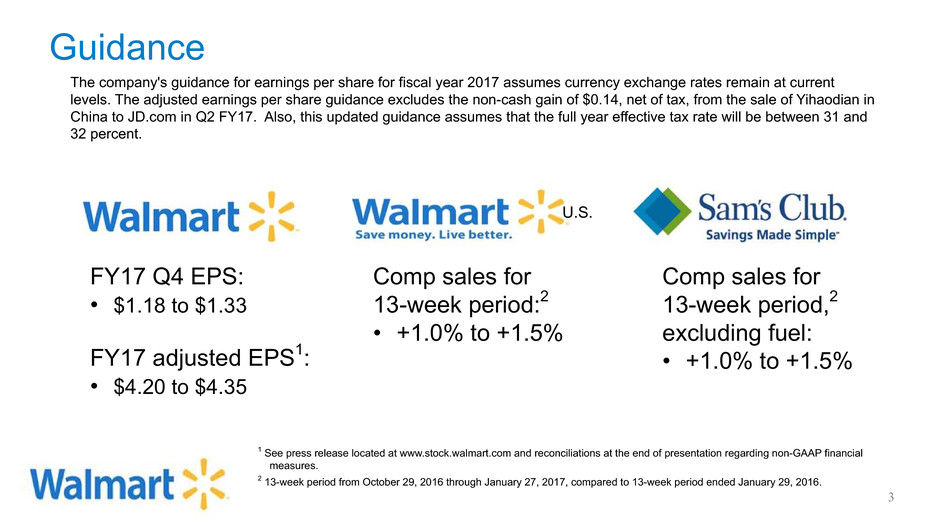
FY17 Q4 EPS:
• $1.18 to $1.33
FY17 adjusted EPS1:
• $4.20 to $4.35
Comp sales for
13-week period:2
• +1.0% to +1.5%
Comp sales for
13-week period,2
excluding fuel:
• +1.0% to +1.5%
1 See press release located at www.stock.walmart.com and reconciliations at the end of presentation regarding non-GAAP financial
measures.
2 13-week period from October 29, 2016 through January 27, 2017, compared to 13-week period ended January 29, 2016.
Guidance
3
The company's guidance for earnings per share for fiscal year 2017 assumes currency exchange rates remain at current
levels. The adjusted earnings per share guidance excludes the non-cash gain of $0.14, net of tax, from the sale of Yihaodian in
China to JD.com in Q2 FY17. Also, this updated guidance assumes that the full year effective tax rate will be between 31 and
32 percent.
U.S.
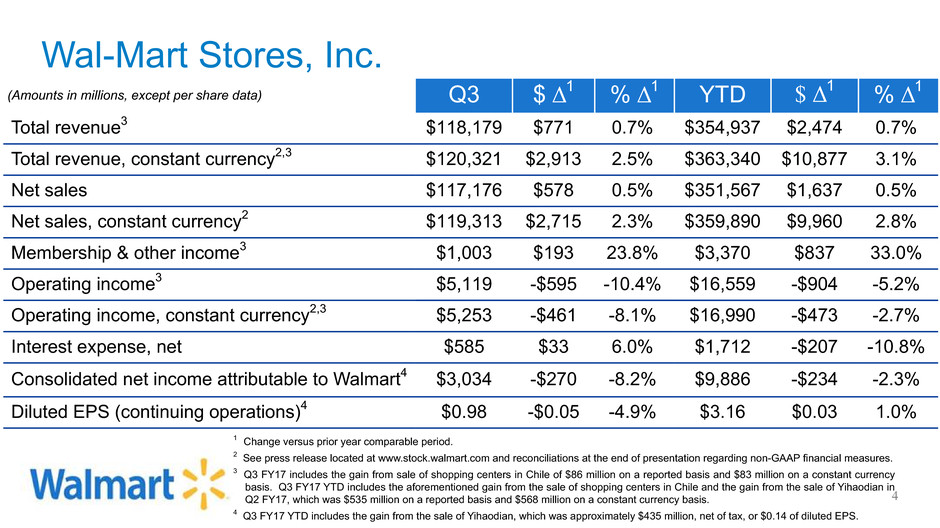
Wal-Mart Stores, Inc.
(Amounts in millions, except per share data) Q3 $ Δ1 % Δ1 YTD $ Δ1 % Δ1
Total revenue3 $118,179 $771 0.7% $354,937 $2,474 0.7%
Total revenue, constant currency2,3 $120,321 $2,913 2.5% $363,340 $10,877 3.1%
Net sales $117,176 $578 0.5% $351,567 $1,637 0.5%
Net sales, constant currency2 $119,313 $2,715 2.3% $359,890 $9,960 2.8%
Membership & other income3 $1,003 $193 23.8% $3,370 $837 33.0%
Operating income3 $5,119 -$595 -10.4% $16,559 -$904 -5.2%
Operating income, constant currency2,3 $5,253 -$461 -8.1% $16,990 -$473 -2.7%
Interest expense, net $585 $33 6.0% $1,712 -$207 -10.8%
Consolidated net income attributable to Walmart4 $3,034 -$270 -8.2% $9,886 -$234 -2.3%
Diluted EPS (continuing operations)4 $0.98 -$0.05 -4.9% $3.16 $0.03 1.0%
1 Change versus prior year comparable period.
2 See press release located at www.stock.walmart.com and reconciliations at the end of presentation regarding non-GAAP financial measures.
3 Q3 FY17 includes the gain from sale of shopping centers in Chile of $86 million on a reported basis and $83 million on a constant currency
basis. Q3 FY17 YTD includes the aforementioned gain from the sale of shopping centers in Chile and the gain from the sale of Yihaodian in
Q2 FY17, which was $535 million on a reported basis and $568 million on a constant currency basis.
4 Q3 FY17 YTD includes the gain from the sale of Yihaodian, which was approximately $435 million, net of tax, or $0.14 of diluted EPS.
4
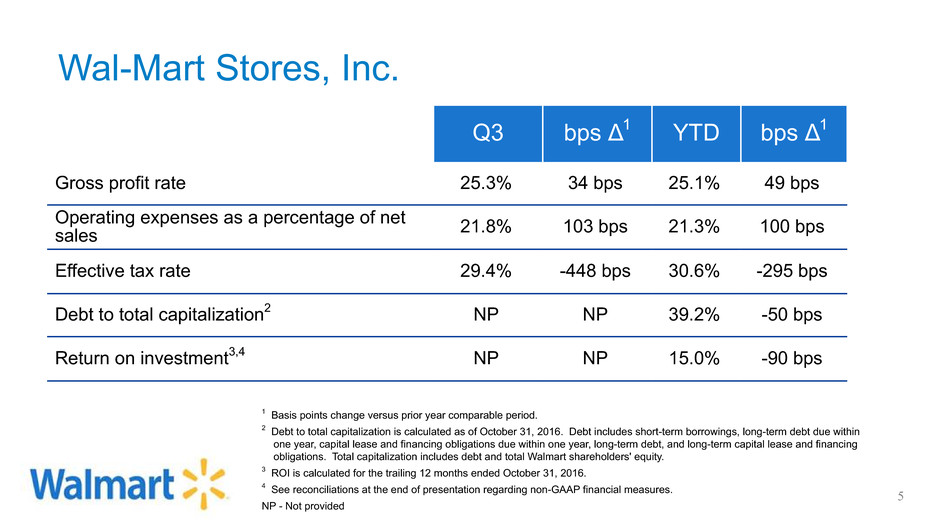
Wal-Mart Stores, Inc.
Q3 bps Δ1 YTD bps Δ1
Gross profit rate 25.3% 34 bps 25.1% 49 bps
Operating expenses as a percentage of net
sales 21.8% 103 bps 21.3% 100 bps
Effective tax rate 29.4% -448 bps 30.6% -295 bps
Debt to total capitalization2 NP NP 39.2% -50 bps
Return on investment3,4 NP NP 15.0% -90 bps
1 Basis points change versus prior year comparable period.
2 Debt to total capitalization is calculated as of October 31, 2016. Debt includes short-term borrowings, long-term debt due within
one year, capital lease and financing obligations due within one year, long-term debt, and long-term capital lease and financing
obligations. Total capitalization includes debt and total Walmart shareholders' equity.
3 ROI is calculated for the trailing 12 months ended October 31, 2016.
4 See reconciliations at the end of presentation regarding non-GAAP financial measures.
NP - Not provided
5
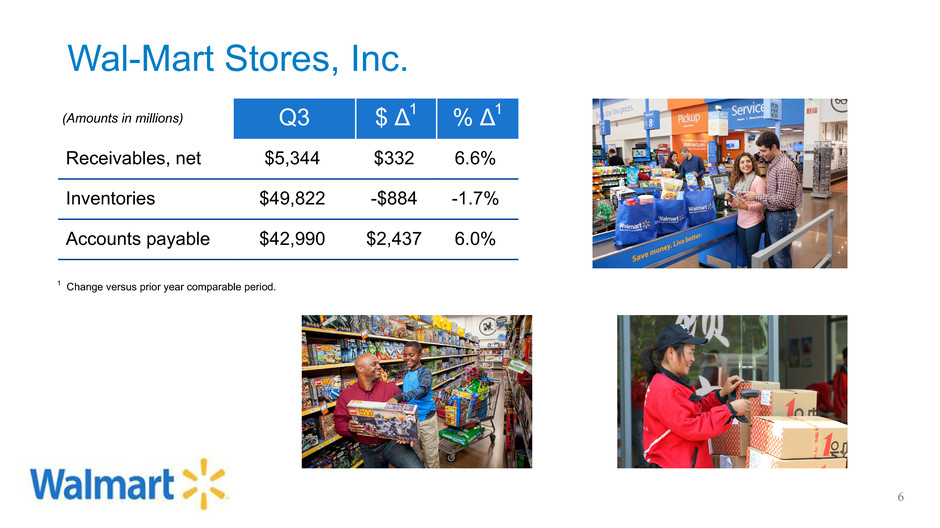
(Amounts in millions) Q3 $ Δ1 % Δ1
Receivables, net $5,344 $332 6.6%
Inventories $49,822 -$884 -1.7%
Accounts payable $42,990 $2,437 6.0%
Wal-Mart Stores, Inc.
1 Change versus prior year comparable period.
6

Wal-Mart Stores, Inc.
(Amounts in millions) YTD $ Δ1
Operating cash flow $19,644 $4,639
Capital expenditures $7,459 -$764
Free cash flow2 $12,185 $5,403
(Amounts in millions) Q3 % Δ1 YTD % Δ1
Dividends $1,549 -1.4% $4,682 -1.0%
Share repurchases3 $1,402 220.8% $6,254 263.6%
Total $2,951 47.0% $10,936 69.6%
1 Change versus prior year comparable period.
2 See press release located at www.stock.walmart.com and reconciliations at the end of presentation regarding non-
GAAP financial measures.
3 $11.3 billion remaining of $20 billion authorization approved in October 2015. 7
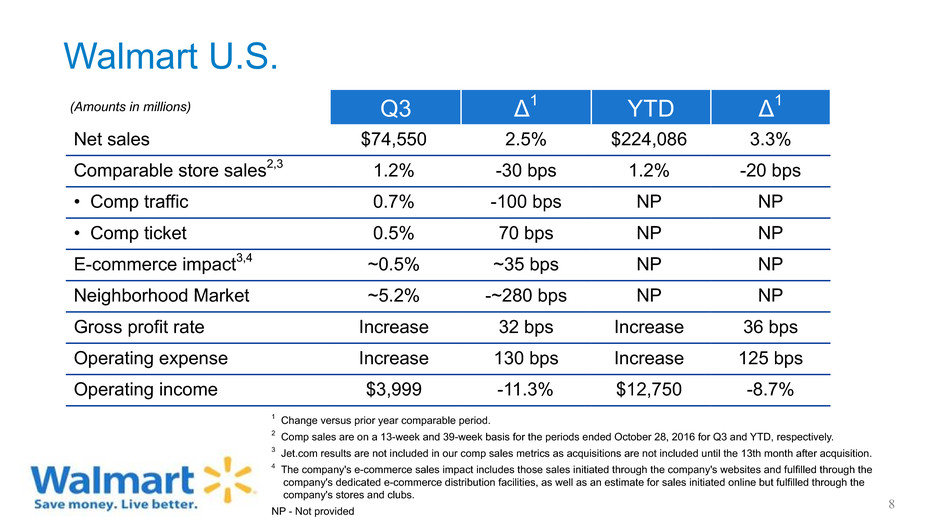
Walmart U.S.
(Amounts in millions) Q3 Δ1 YTD Δ1
Net sales $74,550 2.5% $224,086 3.3%
Comparable store sales2,3 1.2% -30 bps 1.2% -20 bps
• Comp traffic 0.7% -100 bps NP NP
• Comp ticket 0.5% 70 bps NP NP
E-commerce impact3,4 ~0.5% ~35 bps NP NP
Neighborhood Market ~5.2% -~280 bps NP NP
Gross profit rate Increase 32 bps Increase 36 bps
Operating expense Increase 130 bps Increase 125 bps
Operating income $3,999 -11.3% $12,750 -8.7%
1 Change versus prior year comparable period.
2 Comp sales are on a 13-week and 39-week basis for the periods ended October 28, 2016 for Q3 and YTD, respectively.
3 Jet.com results are not included in our comp sales metrics as acquisitions are not included until the 13th month after acquisition.
4 The company's e-commerce sales impact includes those sales initiated through the company's websites and fulfilled through the
company's dedicated e-commerce distribution facilities, as well as an estimate for sales initiated online but fulfilled through the
company's stores and clubs.
NP - Not provided 8

Walmart U.S. - financial highlights
9
Sales
• Net sales increased 2.5%, or approximately $1.8 billion.
• Comp sales increased 1.2% led by comp traffic of 0.7% and improved unit sales. On a 2-year stack basis, comp sales and traffic were up 2.7%
and 2.4%, respectively.
• Market food deflation negatively impacted food comps by approximately 150 basis points.
• Strength in general merchandise and health & wellness was led by home, toys, sporting goods, automotive and OTC.
Gross Margin
• Gross margin increased 32 basis points with improved margin rates across general merchandise, food and consumables.
• Gross margin also benefited from savings in procuring merchandise and lower transportation expense as a result of lower fuel costs.
• Partially offsetting these cost of goods reductions was the continued implementation of the multi-year strategy of incremental price investment.
Expenses
• Expenses increased 8.6% primarily as a result of the associate wage rate increases, as well as investments in technology. Jet.com expenses
were also a contributing factor.
• Last year's Q3 results included a favorable $74 million lease accounting adjustment. Excluding this adjustment, expenses would have increased
8.1%.
Inventory
• Total inventory declined 2% and comp store inventory declined approximately 6%, while in-stock levels improved.
Format growth
• Store growth included net openings of 9 Supercenters (including conversions and relocations) and 18 Neighborhood Markets.
• Expanded online grocery to around 35 new markets and to nearly 200 more locations; this service is now available in over 100 markets and nearly
600 locations.
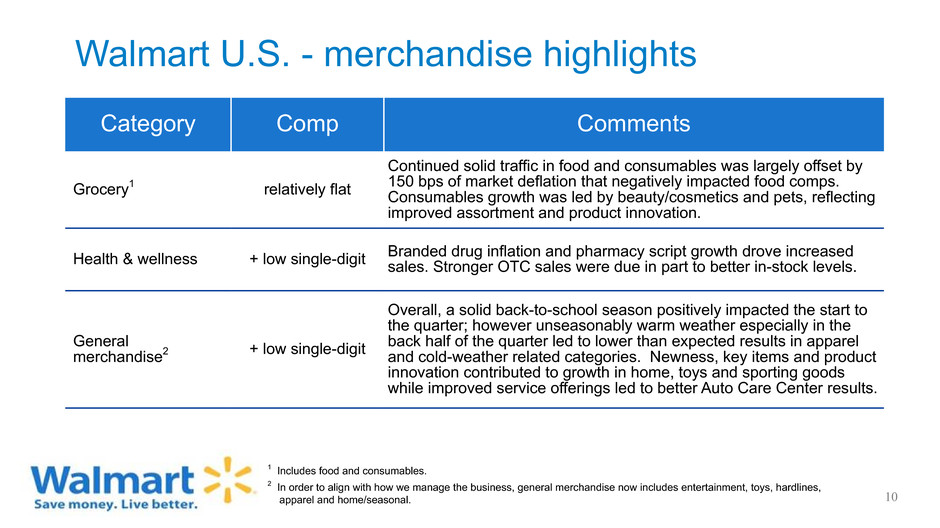
Walmart U.S. - merchandise highlights
Category Comp Comments
Grocery1 relatively flat
Continued solid traffic in food and consumables was largely offset by
150 bps of market deflation that negatively impacted food comps.
Consumables growth was led by beauty/cosmetics and pets, reflecting
improved assortment and product innovation.
Health & wellness + low single-digit Branded drug inflation and pharmacy script growth drove increasedsales. Stronger OTC sales were due in part to better in-stock levels.
General
merchandise2 + low single-digit
Overall, a solid back-to-school season positively impacted the start to
the quarter; however unseasonably warm weather especially in the
back half of the quarter led to lower than expected results in apparel
and cold-weather related categories. Newness, key items and product
innovation contributed to growth in home, toys and sporting goods
while improved service offerings led to better Auto Care Center results.
1 Includes food and consumables.
2 In order to align with how we manage the business, general merchandise now includes entertainment, toys, hardlines,
apparel and home/seasonal. 10

Walmart International
1
(Amounts in millions) Reported
Constant
currency1 Reported
Constant
currency1
Q3 Δ2 Q3 Δ2 YTD Δ2 YTD Δ2
Net sales $28,390 -4.8% $30,527 2.4% $85,094 -6.2% $93,417 3.0%
Gross profit rate Increase 49 bps NP NP Increase 55 bps NP NP
Operating income3 $1,354 1.2% $1,488 11.2% $4,245 15.2% $4,676 26.9%
1 See press release located at www.stock.walmart.com and reconciliations at the end of presentation regarding non-GAAP financial measures.
2 Change versus prior year period.
3 Q3 FY17 results include the gain from the sale of certain shopping malls in Chile, which was $86 million on a reported basis and $83 million on a
constant currency basis. YTD FY17 results include the gain mentioned above as well as the gain from the sale of Yihaodian in Q2 FY17, which
was $535 million on a reported basis and $568 million on a constant currency basis.
NP - Not provided
11
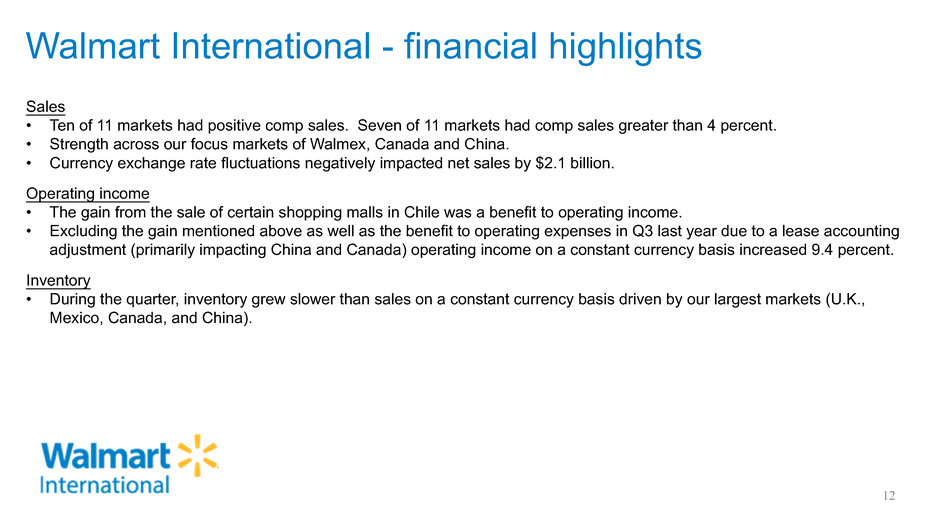
Walmart International - financial highlights
12
Sales
• Ten of 11 markets had positive comp sales. Seven of 11 markets had comp sales greater than 4 percent.
• Strength across our focus markets of Walmex, Canada and China.
• Currency exchange rate fluctuations negatively impacted net sales by $2.1 billion.
Operating income
• The gain from the sale of certain shopping malls in Chile was a benefit to operating income.
• Excluding the gain mentioned above as well as the benefit to operating expenses in Q3 last year due to a lease accounting
adjustment (primarily impacting China and Canada) operating income on a constant currency basis increased 9.4 percent.
Inventory
• During the quarter, inventory grew slower than sales on a constant currency basis driven by our largest markets (U.K.,
Mexico, Canada, and China).

Walmart International - key markets
1 Results are on a constant currency basis. Net sales and comp sales are presented on a nominal, calendar basis.
2 E-commerce results included for the United Kingdom, Walmex and Canada. E-commerce results for Brazil and China are not
included in the table.
3 Change versus prior year comparable period.
4 Comp sales for the United Kingdom are presented excluding fuel.
5 Walmex includes the consolidated results of Mexico and Central America.
6 Excluding a benefit to operating expenses from a lease accounting adjustment in Q3 FY16, operating income on a constant
currency basis would have increased.
Country1,2
Comp3 Net
sales3
Gross
profit
rate3
Operating
income3Sales Traffic Ticket
United Kingdom4 -5.8% -4.2% -1.6% -3.8% Increase Decrease
Walmex5 7.0% 0.8% 6.2% 8.6% Increase Increase3¹
Canada 1.1% 0.2% 0.9% 3.3% Increase Decrease6
Brazil 8.1% 0.5% 7.6% 3.1% Decrease Decrease
China 1.6% -2.7% 4.3% 4.2% Increase Decrease6
13
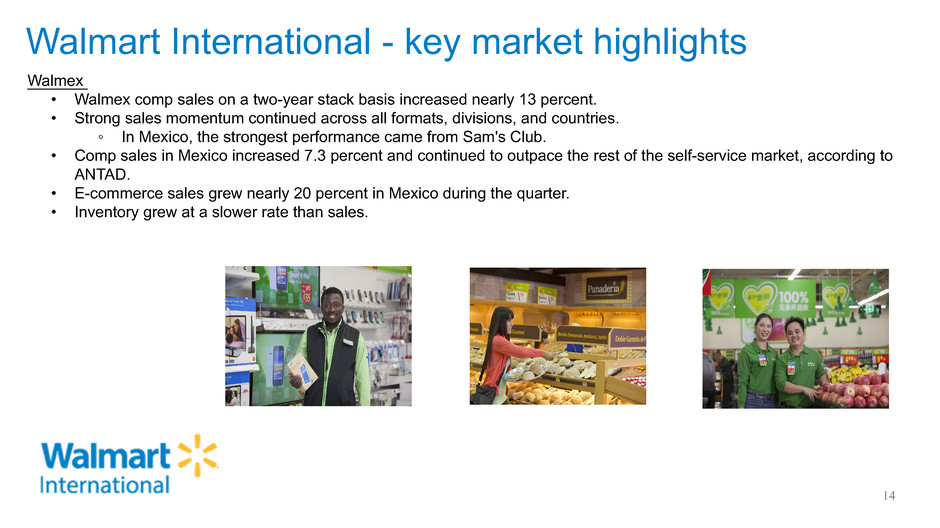
Walmart International - key market highlights
14
Walmex
• Walmex comp sales on a two-year stack basis increased nearly 13 percent.
• Strong sales momentum continued across all formats, divisions, and countries.
◦ In Mexico, the strongest performance came from Sam's Club.
• Comp sales in Mexico increased 7.3 percent and continued to outpace the rest of the self-service market, according to
ANTAD.
• E-commerce sales grew nearly 20 percent in Mexico during the quarter.
• Inventory grew at a slower rate than sales.
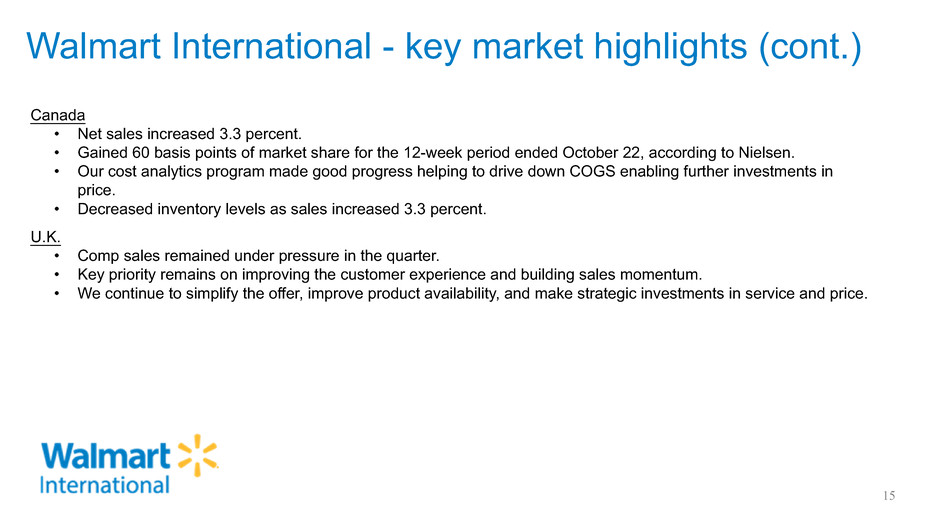
Walmart International - key market highlights (cont.)
15
U.K.
• Comp sales remained under pressure in the quarter.
• Key priority remains on improving the customer experience and building sales momentum.
• We continue to simplify the offer, improve product availability, and make strategic investments in service and price.
Canada
• Net sales increased 3.3 percent.
• Gained 60 basis points of market share for the 12-week period ended October 22, according to Nielsen.
• Our cost analytics program made good progress helping to drive down COGS enabling further investments in
price.
• Decreased inventory levels as sales increased 3.3 percent.

Walmart International - key market highlights (cont.)
China
• Comp sales showed improvement driven by performance in hypermarkets, fresh offering and solid performance during
the Mid-Autumn Festival.
• Focused on driving efficiency, reducing expenses and strengthening our portfolio through ‘We Operate for Less’ and ‘We
Buy for Less’ initiatives.
• Inventory grew at a slower rate than sales.
Brazil
• Delivered solid sales performance including improved traffic trends.
• Both Sam’s and the Cash & Carry format delivered double digit sales growth.
• Decreased inventory levels as sales increased 3.1 percent.
16
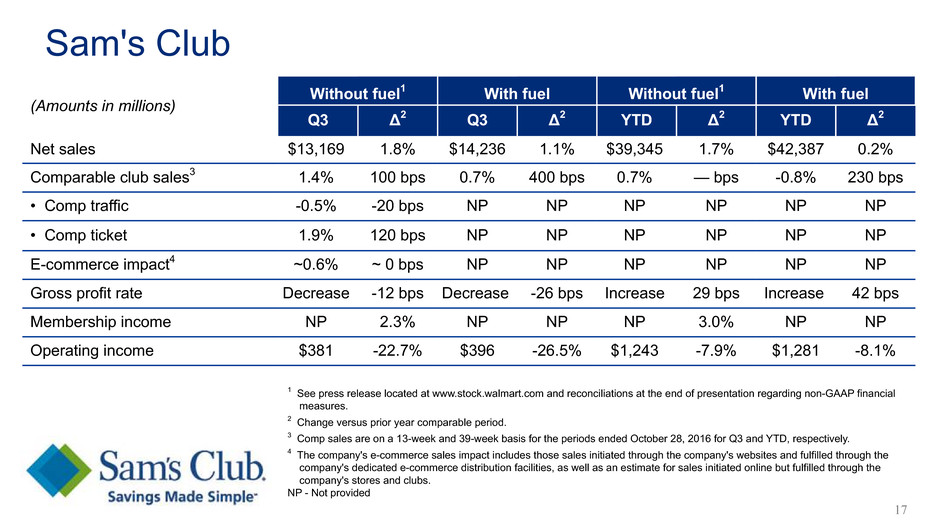
Sam's Club
(Amounts in millions)
Without fuel1 With fuel Without fuel1 With fuel
Q3 Δ2 Q3 Δ2 YTD Δ2 YTD Δ2
Net sales $13,169 1.8% $14,236 1.1% $39,345 1.7% $42,387 0.2%
Comparable club sales3 1.4% 100 bps 0.7% 400 bps 0.7% — bps -0.8% 230 bps
• Comp traffic -0.5% -20 bps NP NP NP NP NP NP
• Comp ticket 1.9% 120 bps NP NP NP NP NP NP
E-commerce impact4 ~0.6% ~ 0 bps NP NP NP NP NP NP
Gross profit rate Decrease -12 bps Decrease -26 bps Increase 29 bps Increase 42 bps
Membership income NP 2.3% NP NP NP 3.0% NP NP
Operating income $381 -22.7% $396 -26.5% $1,243 -7.9% $1,281 -8.1%
1 See press release located at www.stock.walmart.com and reconciliations at the end of presentation regarding non-GAAP financial
measures.
2 Change versus prior year comparable period.
3 Comp sales are on a 13-week and 39-week basis for the periods ended October 28, 2016 for Q3 and YTD, respectively.
4 The company's e-commerce sales impact includes those sales initiated through the company's websites and fulfilled through the
company's dedicated e-commerce distribution facilities, as well as an estimate for sales initiated online but fulfilled through the
company's stores and clubs.
NP - Not provided
17
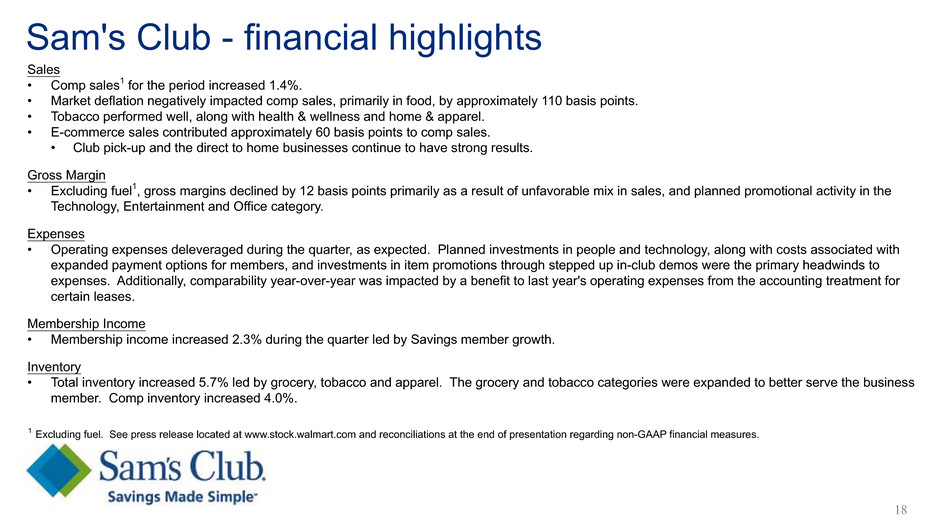
Sam's Club - financial highlights
18
Sales
• Comp sales1 for the period increased 1.4%.
• Market deflation negatively impacted comp sales, primarily in food, by approximately 110 basis points.
• Tobacco performed well, along with health & wellness and home & apparel.
• E-commerce sales contributed approximately 60 basis points to comp sales.
• Club pick-up and the direct to home businesses continue to have strong results.
Gross Margin
• Excluding fuel1, gross margins declined by 12 basis points primarily as a result of unfavorable mix in sales, and planned promotional activity in the
Technology, Entertainment and Office category.
Expenses
• Operating expenses deleveraged during the quarter, as expected. Planned investments in people and technology, along with costs associated with
expanded payment options for members, and investments in item promotions through stepped up in-club demos were the primary headwinds to
expenses. Additionally, comparability year-over-year was impacted by a benefit to last year's operating expenses from the accounting treatment for
certain leases.
Membership Income
• Membership income increased 2.3% during the quarter led by Savings member growth.
Inventory
• Total inventory increased 5.7% led by grocery, tobacco and apparel. The grocery and tobacco categories were expanded to better serve the business
member. Comp inventory increased 4.0%.
1 Excluding fuel. See press release located at www.stock.walmart.com and reconciliations at the end of presentation regarding non-GAAP financial measures.
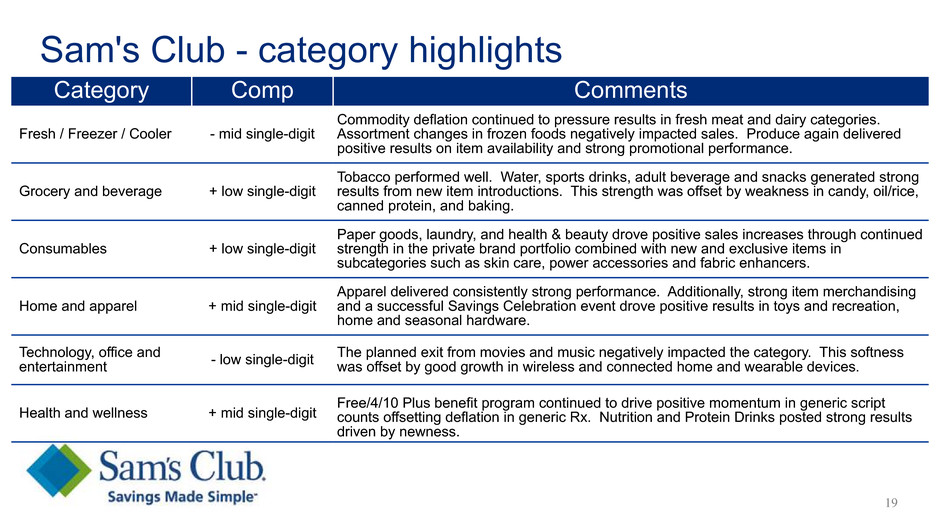
Sam's Club - category highlights
19
Category Comp Comments
Fresh / Freezer / Cooler - mid single-digit
Commodity deflation continued to pressure results in fresh meat and dairy categories.
Assortment changes in frozen foods negatively impacted sales. Produce again delivered
positive results on item availability and strong promotional performance.
Grocery and beverage + low single-digit
Tobacco performed well. Water, sports drinks, adult beverage and snacks generated strong
results from new item introductions. This strength was offset by weakness in candy, oil/rice,
canned protein, and baking.
Consumables + low single-digit
Paper goods, laundry, and health & beauty drove positive sales increases through continued
strength in the private brand portfolio combined with new and exclusive items in
subcategories such as skin care, power accessories and fabric enhancers.
Home and apparel + mid single-digit
Apparel delivered consistently strong performance. Additionally, strong item merchandising
and a successful Savings Celebration event drove positive results in toys and recreation,
home and seasonal hardware.
Technology, office and
entertainment - low single-digit
The planned exit from movies and music negatively impacted the category. This softness
was offset by good growth in wireless and connected home and wearable devices.
Health and wellness + mid single-digit Free/4/10 Plus benefit program continued to drive positive momentum in generic scriptcounts offsetting deflation in generic Rx. Nutrition and Protein Drinks posted strong results
driven by newness.
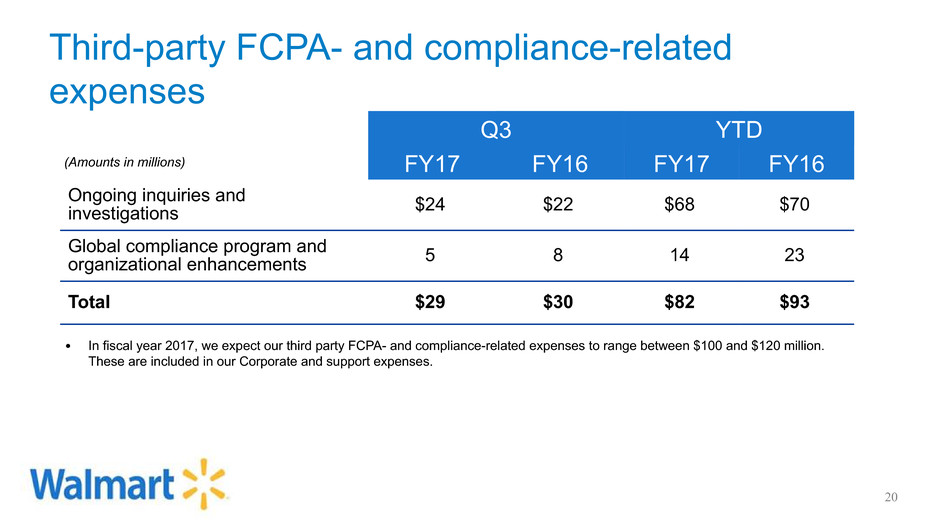
Third-party FCPA- and compliance-related
expenses
Q3 YTD
(Amounts in millions) FY17 FY16 FY17 FY16
Ongoing inquiries and
investigations $24 $22 $68 $70
Global compliance program and
organizational enhancements 5 8 14 23
Total $29 $30 $82 $93
• In fiscal year 2017, we expect our third party FCPA- and compliance-related expenses to range between $100 and $120 million.
These are included in our Corporate and support expenses.
20
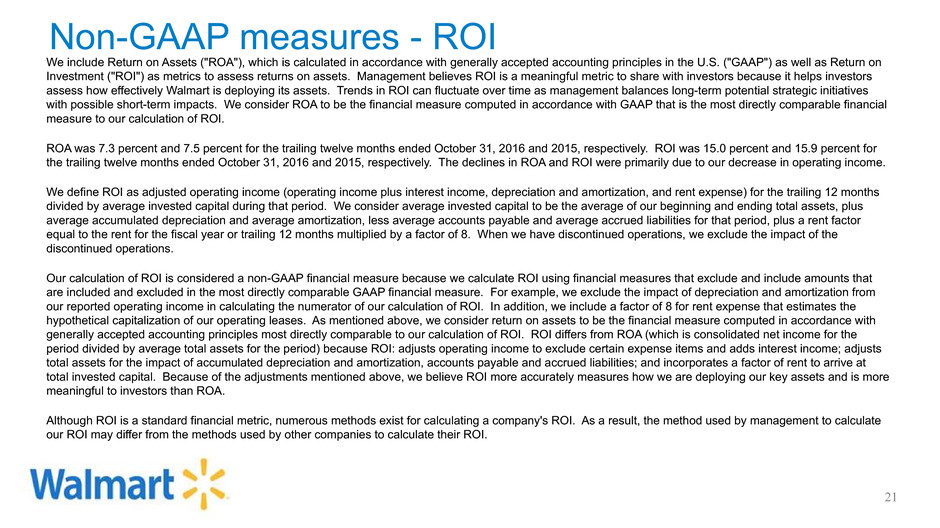
Non-GAAP measures - ROI
We include Return on Assets ("ROA"), which is calculated in accordance with generally accepted accounting principles in the U.S. ("GAAP") as well as Return on
Investment ("ROI") as metrics to assess returns on assets. Management believes ROI is a meaningful metric to share with investors because it helps investors
assess how effectively Walmart is deploying its assets. Trends in ROI can fluctuate over time as management balances long-term potential strategic initiatives
with possible short-term impacts. We consider ROA to be the financial measure computed in accordance with GAAP that is the most directly comparable financial
measure to our calculation of ROI.
ROA was 7.3 percent and 7.5 percent for the trailing twelve months ended October 31, 2016 and 2015, respectively. ROI was 15.0 percent and 15.9 percent for
the trailing twelve months ended October 31, 2016 and 2015, respectively. The declines in ROA and ROI were primarily due to our decrease in operating income.
We define ROI as adjusted operating income (operating income plus interest income, depreciation and amortization, and rent expense) for the trailing 12 months
divided by average invested capital during that period. We consider average invested capital to be the average of our beginning and ending total assets, plus
average accumulated depreciation and average amortization, less average accounts payable and average accrued liabilities for that period, plus a rent factor
equal to the rent for the fiscal year or trailing 12 months multiplied by a factor of 8. When we have discontinued operations, we exclude the impact of the
discontinued operations.
Our calculation of ROI is considered a non-GAAP financial measure because we calculate ROI using financial measures that exclude and include amounts that
are included and excluded in the most directly comparable GAAP financial measure. For example, we exclude the impact of depreciation and amortization from
our reported operating income in calculating the numerator of our calculation of ROI. In addition, we include a factor of 8 for rent expense that estimates the
hypothetical capitalization of our operating leases. As mentioned above, we consider return on assets to be the financial measure computed in accordance with
generally accepted accounting principles most directly comparable to our calculation of ROI. ROI differs from ROA (which is consolidated net income for the
period divided by average total assets for the period) because ROI: adjusts operating income to exclude certain expense items and adds interest income; adjusts
total assets for the impact of accumulated depreciation and amortization, accounts payable and accrued liabilities; and incorporates a factor of rent to arrive at
total invested capital. Because of the adjustments mentioned above, we believe ROI more accurately measures how we are deploying our key assets and is more
meaningful to investors than ROA.
Although ROI is a standard financial metric, numerous methods exist for calculating a company's ROI. As a result, the method used by management to calculate
our ROI may differ from the methods used by other companies to calculate their ROI.
21
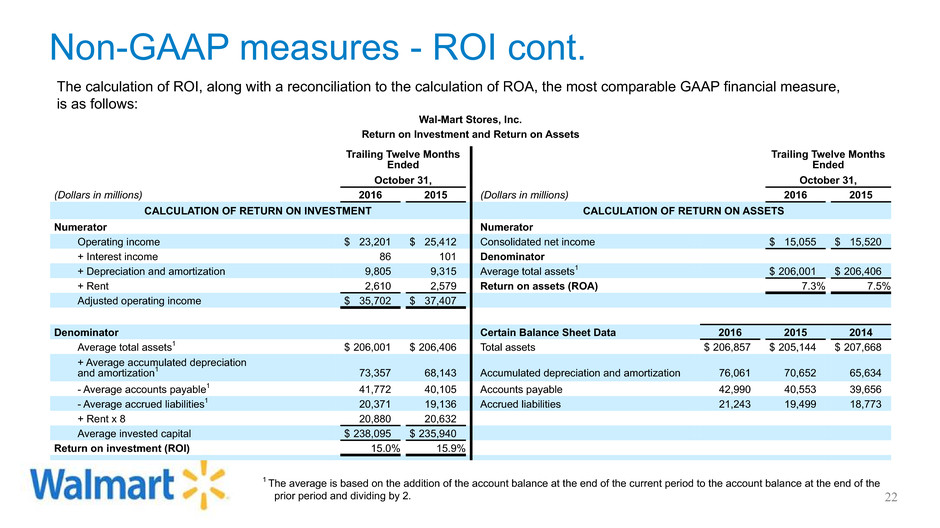
Non-GAAP measures - ROI cont.
The calculation of ROI, along with a reconciliation to the calculation of ROA, the most comparable GAAP financial measure,
is as follows:
Wal-Mart Stores, Inc.
Return on Investment and Return on Assets
Trailing Twelve Months
Ended
Trailing Twelve Months
Ended
October 31, October 31,
(Dollars in millions) 2016 2015 (Dollars in millions) 2016 2015
CALCULATION OF RETURN ON INVESTMENT CALCULATION OF RETURN ON ASSETS
Numerator Numerator
Operating income $ 23,201 $ 25,412 Consolidated net income $ 15,055 $ 15,520
+ Interest income 86 101 Denominator
+ Depreciation and amortization 9,805 9,315 Average total assets1 $ 206,001 $ 206,406
+ Rent 2,610 2,579 Return on assets (ROA) 7.3% 7.5%
Adjusted operating income $ 35,702 $ 37,407
Denominator Certain Balance Sheet Data 2016 2015 2014
Average total assets1 $ 206,001 $ 206,406 Total assets $ 206,857 $ 205,144 $ 207,668
+ Average accumulated depreciation
and amortization1 73,357 68,143 Accumulated depreciation and amortization 76,061 70,652 65,634
- Average accounts payable1 41,772 40,105 Accounts payable 42,990 40,553 39,656
- Average accrued liabilities1 20,371 19,136 Accrued liabilities 21,243 19,499 18,773
+ Rent x 8 20,880 20,632
Average invested capital $ 238,095 $ 235,940
Return on investment (ROI) 15.0% 15.9%
1 The average is based on the addition of the account balance at the end of the current period to the account balance at the end of the
prior period and dividing by 2. 22
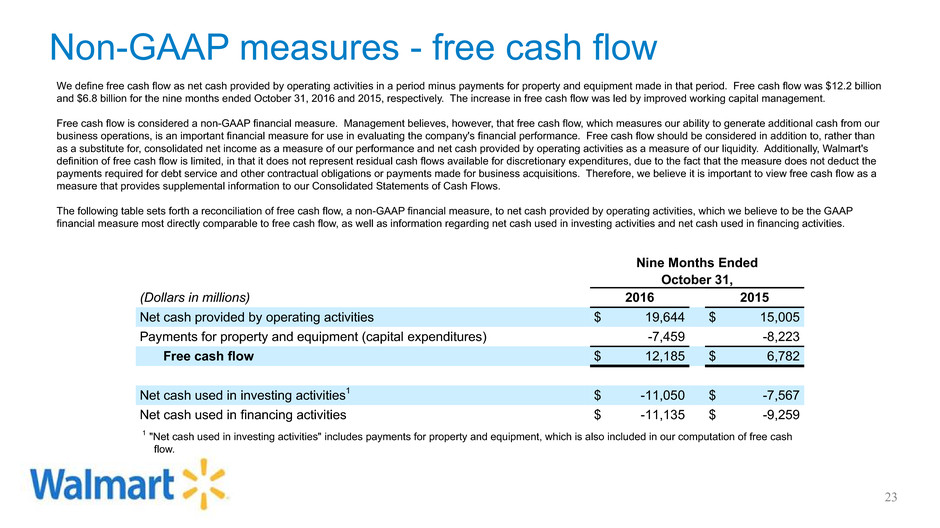
Non-GAAP measures - free cash flow
We define free cash flow as net cash provided by operating activities in a period minus payments for property and equipment made in that period. Free cash flow was $12.2 billion
and $6.8 billion for the nine months ended October 31, 2016 and 2015, respectively. The increase in free cash flow was led by improved working capital management.
Free cash flow is considered a non-GAAP financial measure. Management believes, however, that free cash flow, which measures our ability to generate additional cash from our
business operations, is an important financial measure for use in evaluating the company's financial performance. Free cash flow should be considered in addition to, rather than
as a substitute for, consolidated net income as a measure of our performance and net cash provided by operating activities as a measure of our liquidity. Additionally, Walmart's
definition of free cash flow is limited, in that it does not represent residual cash flows available for discretionary expenditures, due to the fact that the measure does not deduct the
payments required for debt service and other contractual obligations or payments made for business acquisitions. Therefore, we believe it is important to view free cash flow as a
measure that provides supplemental information to our Consolidated Statements of Cash Flows.
The following table sets forth a reconciliation of free cash flow, a non-GAAP financial measure, to net cash provided by operating activities, which we believe to be the GAAP
financial measure most directly comparable to free cash flow, as well as information regarding net cash used in investing activities and net cash used in financing activities.
Nine Months Ended
October 31,
(Dollars in millions) 2016 2015
Net cash provided by operating activities $ 19,644 $ 15,005
Payments for property and equipment (capital expenditures) -7,459 -8,223
Free cash flow $ 12,185 $ 6,782
Net cash used in investing activities1 $ -11,050 $ -7,567
Net cash used in financing activities $ -11,135 $ -9,259
1 "Net cash used in investing activities" includes payments for property and equipment, which is also included in our computation of free cash
flow.
23
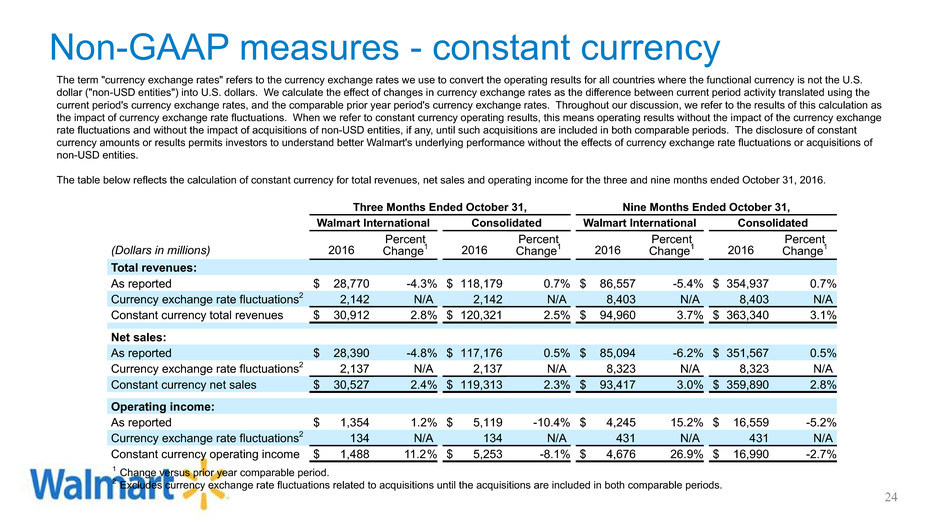
1 Change versus prior year comparable period.
2 Excludes currency exchange rate fluctuations related to acquisitions until the acquisitions are included in both comparable periods.
Non-GAAP measures - constant currency
Three Months Ended October 31, Nine Months Ended October 31,
Walmart International Consolidated Walmart International Consolidated
(Dollars in millions) 2016
Percent
Change1 2016
Percent
Change1 2016
Percent
Change1 2016
Percent
Change1
Total revenues:
As reported $ 28,770 -4.3% $ 118,179 0.7% $ 86,557 -5.4% $ 354,937 0.7%
Currency exchange rate fluctuations2 2,142 N/A 2,142 N/A 8,403 N/A 8,403 N/A
Constant currency total revenues $ 30,912 2.8% $ 120,321 2.5% $ 94,960 3.7% $ 363,340 3.1%
Net sales:
As reported $ 28,390 -4.8% $ 117,176 0.5% $ 85,094 -6.2% $ 351,567 0.5%
Currency exchange rate fluctuations2 2,137 N/A 2,137 N/A 8,323 N/A 8,323 N/A
Constant currency net sales $ 30,527 2.4% $ 119,313 2.3% $ 93,417 3.0% $ 359,890 2.8%
Operating income:
As reported $ 1,354 1.2% $ 5,119 -10.4% $ 4,245 15.2% $ 16,559 -5.2%
Currency exchange rate fluctuations2 134 N/A 134 N/A 431 N/A 431 N/A
Constant currency operating income $ 1,488 11.2% $ 5,253 -8.1% $ 4,676 26.9% $ 16,990 -2.7%
24
The term "currency exchange rates" refers to the currency exchange rates we use to convert the operating results for all countries where the functional currency is not the U.S.
dollar ("non-USD entities") into U.S. dollars. We calculate the effect of changes in currency exchange rates as the difference between current period activity translated using the
current period's currency exchange rates, and the comparable prior year period's currency exchange rates. Throughout our discussion, we refer to the results of this calculation as
the impact of currency exchange rate fluctuations. When we refer to constant currency operating results, this means operating results without the impact of the currency exchange
rate fluctuations and without the impact of acquisitions of non-USD entities, if any, until such acquisitions are included in both comparable periods. The disclosure of constant
currency amounts or results permits investors to understand better Walmart's underlying performance without the effects of currency exchange rate fluctuations or acquisitions of
non-USD entities.
The table below reflects the calculation of constant currency for total revenues, net sales and operating income for the three and nine months ended October 31, 2016.
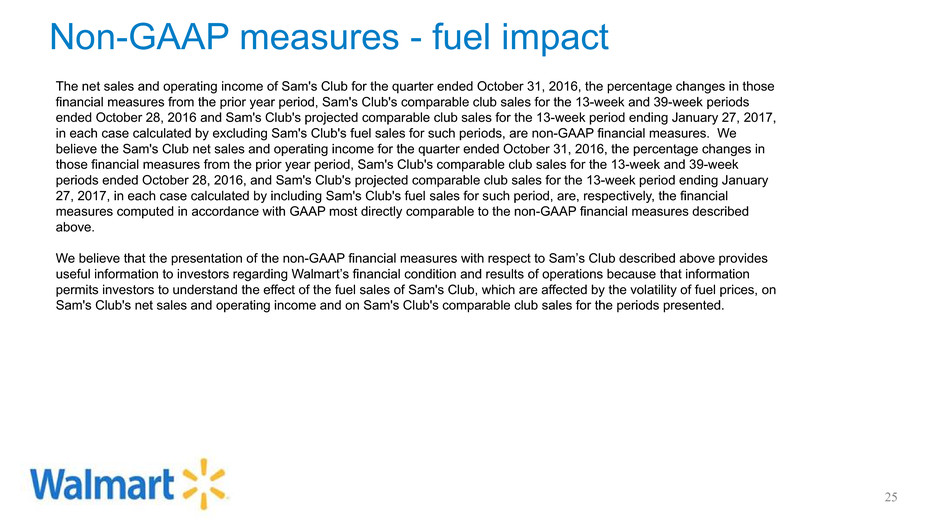
Non-GAAP measures - fuel impact
The net sales and operating income of Sam's Club for the quarter ended October 31, 2016, the percentage changes in those
financial measures from the prior year period, Sam's Club's comparable club sales for the 13-week and 39-week periods
ended October 28, 2016 and Sam's Club's projected comparable club sales for the 13-week period ending January 27, 2017,
in each case calculated by excluding Sam's Club's fuel sales for such periods, are non-GAAP financial measures. We
believe the Sam's Club net sales and operating income for the quarter ended October 31, 2016, the percentage changes in
those financial measures from the prior year period, Sam's Club's comparable club sales for the 13-week and 39-week
periods ended October 28, 2016, and Sam's Club's projected comparable club sales for the 13-week period ending January
27, 2017, in each case calculated by including Sam's Club's fuel sales for such period, are, respectively, the financial
measures computed in accordance with GAAP most directly comparable to the non-GAAP financial measures described
above.
We believe that the presentation of the non-GAAP financial measures with respect to Sam’s Club described above provides
useful information to investors regarding Walmart’s financial condition and results of operations because that information
permits investors to understand the effect of the fuel sales of Sam's Club, which are affected by the volatility of fuel prices, on
Sam's Club's net sales and operating income and on Sam's Club's comparable club sales for the periods presented.
25
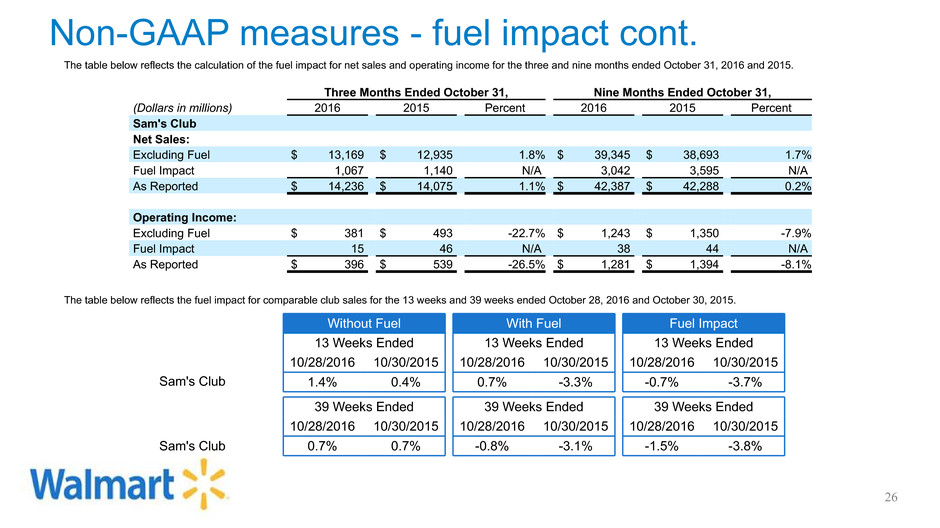
Non-GAAP measures - fuel impact cont.
The table below reflects the calculation of the fuel impact for net sales and operating income for the three and nine months ended October 31, 2016 and 2015.
Three Months Ended October 31, Nine Months Ended October 31,
(Dollars in millions) 2016 2015 Percent 2016 2015 Percent
Sam's Club
Net Sales:
Excluding Fuel $ 13,169 $ 12,935 1.8% $ 39,345 $ 38,693 1.7%
Fuel Impact 1,067 1,140 N/A 3,042 3,595 N/A
As Reported $ 14,236 $ 14,075 1.1% $ 42,387 $ 42,288 0.2%
Operating Income:
Excluding Fuel $ 381 $ 493 -22.7% $ 1,243 $ 1,350 -7.9%
Fuel Impact 15 46 N/A 38 44 N/A
As Reported $ 396 $ 539 -26.5% $ 1,281 $ 1,394 -8.1%
The table below reflects the fuel impact for comparable club sales for the 13 weeks and 39 weeks ended October 28, 2016 and October 30, 2015.
Without Fuel With Fuel Fuel Impact
13 Weeks Ended 13 Weeks Ended 13 Weeks Ended
10/28/2016 10/30/2015 10/28/2016 10/30/2015 10/28/2016 10/30/2015
Sam's Club 1.4% 0.4% 0.7% -3.3% -0.7% -3.7%
39 Weeks Ended 39 Weeks Ended 39 Weeks Ended
10/28/2016 10/30/2015 10/28/2016 10/30/2015 10/28/2016 10/30/2015
Sam's Club 0.7% 0.7% -0.8% -3.1% -1.5% -3.8%
26
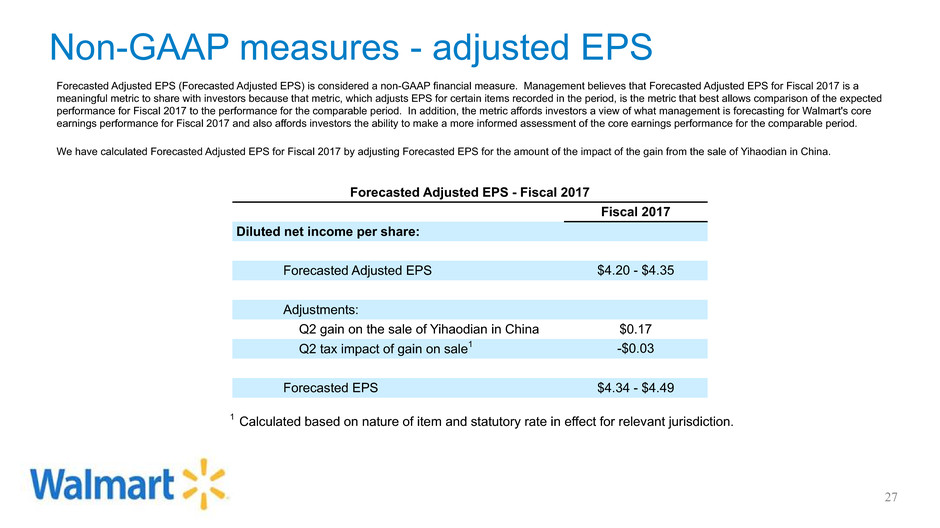
Non-GAAP measures - adjusted EPS
Forecasted Adjusted EPS (Forecasted Adjusted EPS) is considered a non-GAAP financial measure. Management believes that Forecasted Adjusted EPS for Fiscal 2017 is a
meaningful metric to share with investors because that metric, which adjusts EPS for certain items recorded in the period, is the metric that best allows comparison of the expected
performance for Fiscal 2017 to the performance for the comparable period. In addition, the metric affords investors a view of what management is forecasting for Walmart's core
earnings performance for Fiscal 2017 and also affords investors the ability to make a more informed assessment of the core earnings performance for the comparable period.
We have calculated Forecasted Adjusted EPS for Fiscal 2017 by adjusting Forecasted EPS for the amount of the impact of the gain from the sale of Yihaodian in China.
27
Forecasted Adjusted EPS - Fiscal 2017
Fiscal 2017
Diluted net income per share:
Forecasted Adjusted EPS $4.20 - $4.35
Adjustments:
Q2 gain on the sale of Yihaodian in China $0.17
Q2 tax impact of gain on sale1 -$0.03
Forecasted EPS $4.34 - $4.49
1 Calculated based on nature of item and statutory rate in effect for relevant jurisdiction.
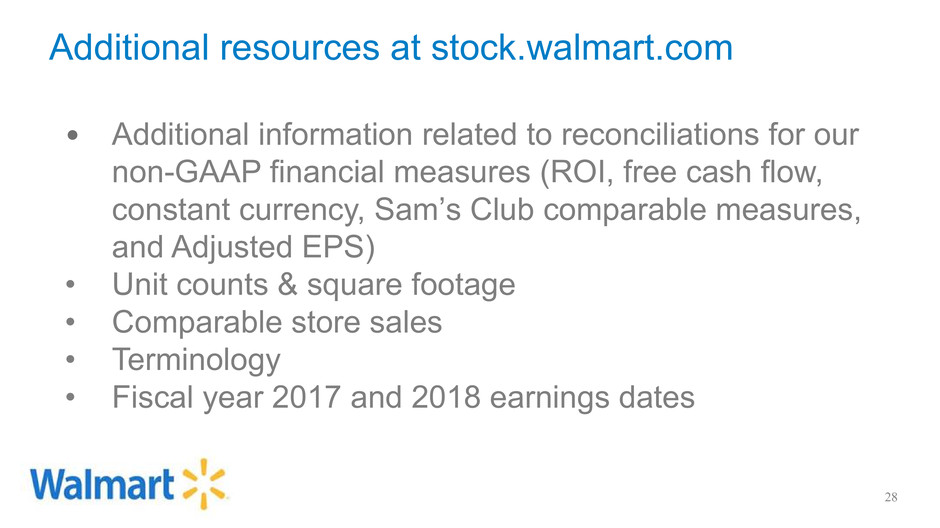
• Additional information related to reconciliations for our
non-GAAP financial measures (ROI, free cash flow,
constant currency, Sam’s Club comparable measures,
and Adjusted EPS)
• Unit counts & square footage
• Comparable store sales
• Terminology
• Fiscal year 2017 and 2018 earnings dates
Additional resources at stock.walmart.com
28
